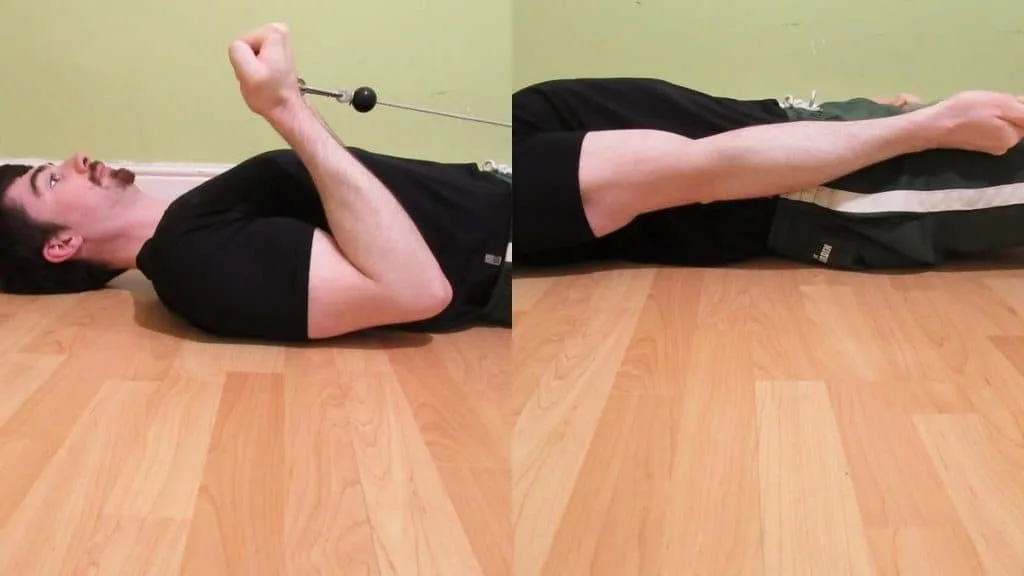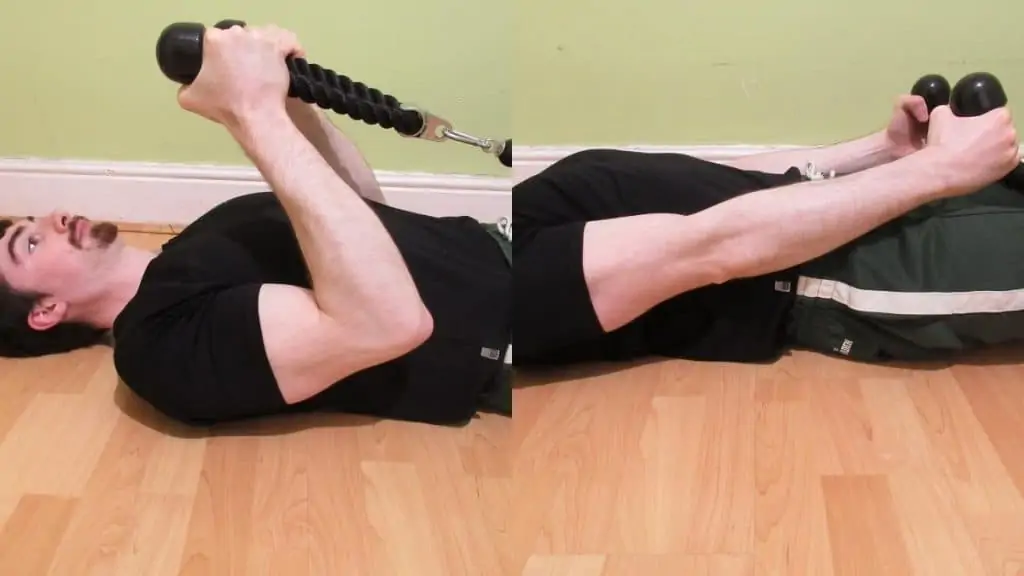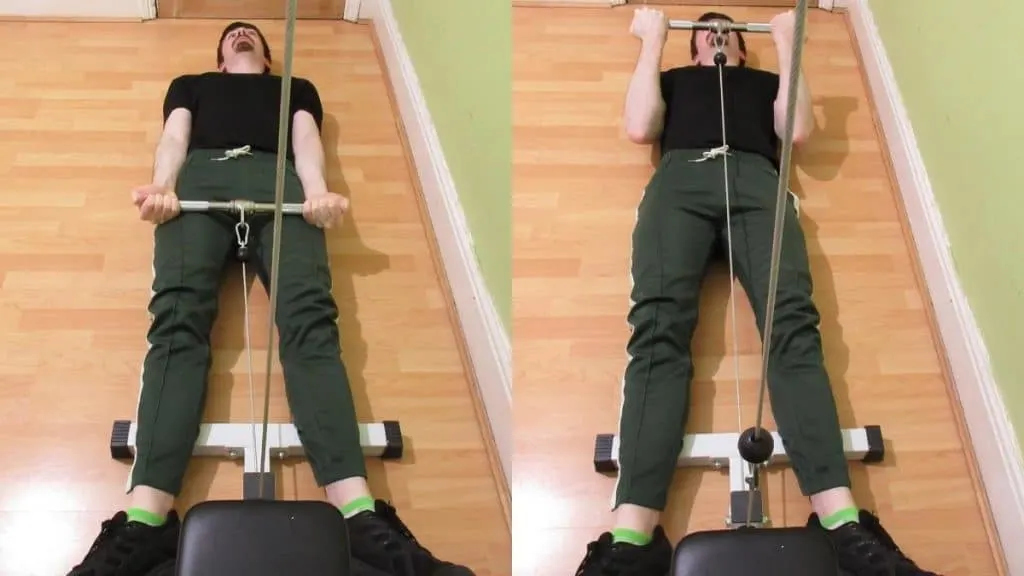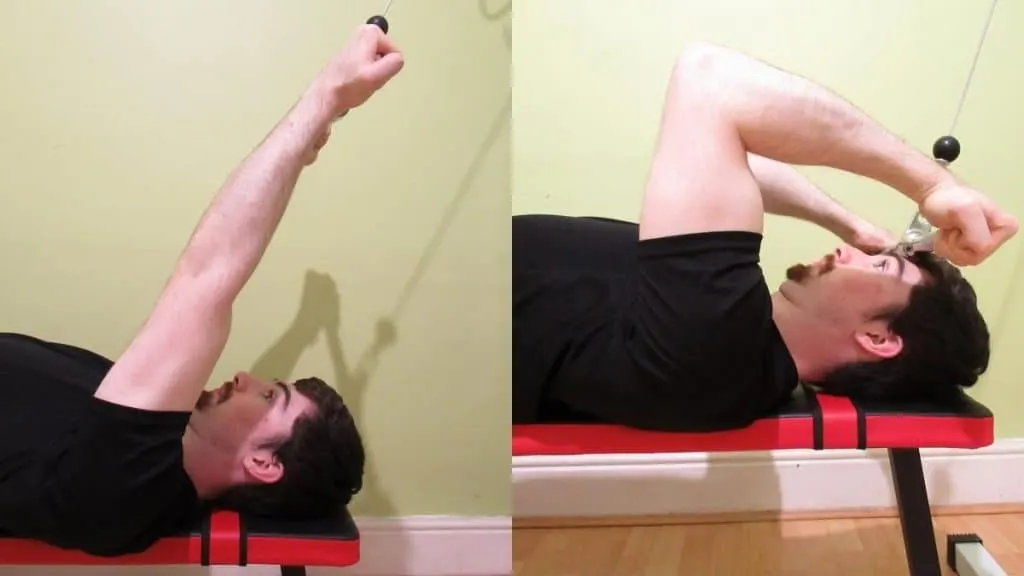The biceps brachii is a small and simple muscle group, relatively speaking. But in order to develop this prominent muscle to its fullest potential, you need to train it from a variety of different angles.
This is so because the muscle fibers of the biceps are split into a long head and short head, which means that you need to do exercises that work both heads in to recruit all of the muscle fibers, and thus achieve optimal development.
Although the lying cable curl isn’t as simple to set up and perform as the regular cable bicep curl, it has some intriguing muscle-building benefits that any keen weight lifter will want to take advantage of.
Related: Bicep shoulder workout
Lying cable curl exercise details
- Other Names: Cable lying overhead curl
- Main Muscles: Biceps brachii
- Secondary Muscles: Forearm flexors, brachialis, brachioradialis
- Exercise Type: Isolation
- Exercise Mechanics: Isolation
- Difficulty Level: Intermediate
- Equipment Needed: Cable machine, straight bar attachment
How to do lying cable curls
- Connect a straight bar attachment to the low pulley of a cable machine.
- Sit on the floor (or on a seated row station) and grab the bar with a shoulder-width underhand grip.
- With the bar firmly in your hands, lie back and tuck your elbows into your sides.
- Curl the bar toward your shoulders until your forearms touch your biceps.
- Hold the contraction for a brief second and then lower the weight until your elbows are almost completely locked out.
- Repeat the motion for 3-4 sets of 12-15 reps.
Lying cable curl benefits
Doing the lying cable bicep curl might earn you a few stares and tut-tuts from some old-school lifters who think that free weights are the only acceptable training tool. However, any initial embarrassment that you may feel will undoubtedly be worth the extra bicep growth that this exercise naturally produces when you perform it consistently.
Better bicep isolation

Regular bicep curls, whether standing or seated, are very easy to cheat on because you can easily swing the weight up with your shoulders, legs, hips, or back, and in some cases, all four of these body parts. As you know, unless the cheating is moderate and tempered with a very controlled eccentric, then you’re always best off lightening the weight and lifting with proper form.
But even knowing the correct technique, it can be hard to maintain optimal lifting form as your biceps fatigue.
That’s where lying cable curls come in.
Because you’re laid on the floor, you couldn’t use your back or legs to swing the weight up even if you wanted to. As a result, you can better isolate your biceps and potentially generate faster muscle growth (diet and recovery permitting) because you can focus 100% of your attention on purely stretching and squeezing your biceps. [1]
Of course, a few degrees of shoulder movement is fine as you curl the weight up. After all, the bicep is a shoulder flexor (albeit a weak one), and you may actually find that the peak contraction becomes even more intensified when you let your shoulders come forward slightly as you squeeze your biceps.
Stronger bicep contraction

In contrast to the majority arm exercises, which are most difficult in the middle of the repetition, lying cable curls become harder as the rep progresses. This unique strength curve results in a more intense peak contraction because the movement is most challenging when your biceps are in their shortest anatomical position. So in this regard, it’s an excellent high cable curl alternative.
Because of this pump-friendly resistance curve, lying cable curls are fantastic exercises for improving your bicep mind-muscle connection because they really force you to squeeze your biceps in order to complete the rep. [2]
Simple setup

While the positioning of the lying cable bicep curl may feel a bit awkward initially, the actual setup is remarkably simple. You don’t need to load any weights onto a bar, you don’t have to wait for a particular set of dumbbells to become available, and you don’t even need to hog an entire cable machine.
All you need is one low pulley, a straight bar, and some space to lie down. Then all you need is the mental toughness to tolerate the intense lactic acid that this bicep-pumping exercise inevitably creates.
Lying cable curl alternatives and variations
Below you’ll find the 3 most effective variations of the lying cable curl. But if you want a complete alternative, then check out these other proven weight lifting exercises that we’ve linked to here.
- Cable reverse curls
- Guillotine cable curl
- Seated bicep cable curl
- Lying dumbbell hammer curl
- Lying bicep curl
Cable lying concentration curl

The cable lying concentration curl is an effective bicep exercise for improving your mind-muscle connection because it produces a very intense peak contraction. The downside is that the setup is much trickier, especially if you train in a busy gym. Why?
Because you need to wheel a bench from the free weight area to a cable machine. In this time, another well-intentioned gym member may have already hopped on your cable station and started their set.
Moreover, since you perform this exercise with a high pulley, the resistance is always trying to pull your body off the bench. So if you have a weak core, then you definitely want to do this exercise at the end of a workout when your biceps are already quite fatigued.
One-arm lying cable curl

As mentioned above, lying cable concentration curls are tricky to perform if you have strong biceps because your core might not be able to keep up with your arm strength. This is particularly likely to happen if you’re curling more than your bodyweight.
The remedy for this is to train one arm at a time. This way, you’ll be lifting around half the weight, which not only gets rid of the core stability problem but, if anything, the single-arm version will further improve your mind-muscle connection because now your brain only has to focus on contracting one muscle at a time.
Lying wide grip cable curl

It seems like everyone always wants to use a close grip to try and isolate their outer biceps (which is impossible because you can only emphasize the heads of a muscle). But if anything, performing wide-grip lying cable curls is better for overall mass because you can lift more weight.
Now, wide-grip needn’t mean a hand position that’s double the regular shoulder width grip. Even moving your hands out a couple of inches is enough to shift the emphasis onto the short head of your biceps.
You can also see our guide to the most effective cable bicep exercises if you want to design your own optimal arm training program.
Read More: 30 min bicep workout
Conclusion: Should you include lying cable curls in your workout routine?

The lying cable curl is an ideal exercise to include early on in your arm workout. This is so because it works your biceps in a very short anatomical position. And as we know from kinesiology, muscles are weakest in their fully shortened and fully lengthened positions.
So by performing the lying cable curl first or second in your routine, you can give your full attention and muscle force to what is likely to be one of the more challenging arm exercises that you’ll perform in your training career.
References
- Rutherford, O. M., & Jones, D. A. (1986). The role of learning and coordination in strength training. European Journal of Applied Physiology and Occupational Physiology, 55(1), 100–105. https://doi.org/10.1007/bf00422902
- Calatayud, J., Vinstrup, J., Jakobsen, M. D., Sundstrup, E., Brandt, M., Jay, K., Colado, J. C., & Andersen, L. L. (2015). Importance of mind-muscle connection during progressive resistance training. European Journal of Applied Physiology, 116(3), 527–533. https://doi.org/10.1007/s00421-015-3305-7

